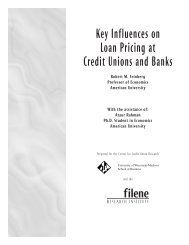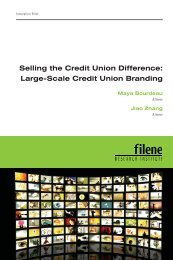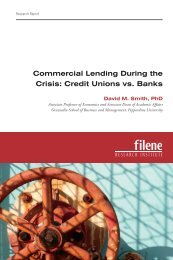Credit Union and Cooperative Patronage Refunds - Filene ...
Credit Union and Cooperative Patronage Refunds - Filene ...
Credit Union and Cooperative Patronage Refunds - Filene ...
Create successful ePaper yourself
Turn your PDF publications into a flip-book with our unique Google optimized e-Paper software.
activities with their credit union to the equity retained from each<br />
member’s activities or the income generated from each member’s<br />
activities. Pure co-op theory 5 takes issue with this approach, because<br />
if all earnings belong to members, then all earnings should be<br />
distributed either with cash or with allocated equity. Hence, all or<br />
substantially all of a co-op’s patronage earnings should be distributed<br />
to members on a patronage basis. There should be an observable link<br />
between each member’s use <strong>and</strong> the member’s capitalization of the<br />
co-op.<br />
This credit union deviation from co-op allocated equity principles<br />
of retaining earnings as undivided equity capital is more dramatic in<br />
a theoretic sense than it is in a practical sense. The following comparisons<br />
of credit unions with agricultural credit associations (ACAs)<br />
illustrate that even though credit unions do not distribute their<br />
earnings with allocated equity or undertake to eventually redeem that<br />
equity, credit unions are quite similar in this respect (<strong>and</strong> others) to<br />
ACAs, which have been functioning as co-op financial institutions<br />
since as early as 1916.<br />
The Farm <strong>Credit</strong> System includes 81 ACAs across the country that<br />
provide short- <strong>and</strong> long-term financing to agricultural producers<br />
(farmers). ACAs operate on a cooperative basis, as does the entire<br />
Farm <strong>Credit</strong> System. Whereas in a credit union the members hold<br />
the voting control <strong>and</strong> are eligible to serve on the board of directors,<br />
in an ACA, the farmers are the voting members <strong>and</strong> are elected to<br />
serve on the board of directors.<br />
The 27 credit unions in the Callahan study distributed on average<br />
23% of their earnings as a cash patronage refund, whereas the<br />
81 ACAs paid 21.5% of their earnings as a cash patronage refund.<br />
The ACAs retained $4.0M per year in allocated equity to capitalize<br />
the ACA, amounting to 18% of their earnings (<strong>and</strong> redeemed $2.4M<br />
per year on average during those years), while the credit unions did<br />
not distribute any patronage refunds with allocated equity.<br />
ACAs <strong>and</strong> credit unions each retain substantial portions of their<br />
earnings (60% <strong>and</strong> 75%, respectively) as permanent unallocated<br />
equity. Even for ACAs, this approach is not consistent with the co-op<br />
Figure 1: Average of 27 <strong>Credit</strong> <strong>Union</strong>s Compared with Average of 81 ACAs<br />
Average of 2008, 2009, <strong>and</strong> 2010 <strong>Credit</strong> unions % Total ACAs % Total<br />
Cash patronage refund 822,800 23.34 4,836,948 21.56<br />
<strong>Patronage</strong> refund in allocated equity — 0.00 4,028,708 17.96<br />
Undivided/Unallocated earnings 2,703,149 76.66 13,192,951 58.81<br />
Income tax on co-op’s earnings — 0.00 376,051 1.68<br />
Total earnings (average per co-op) $3,525,949 100.00 $22,434,658 100.00<br />
8








